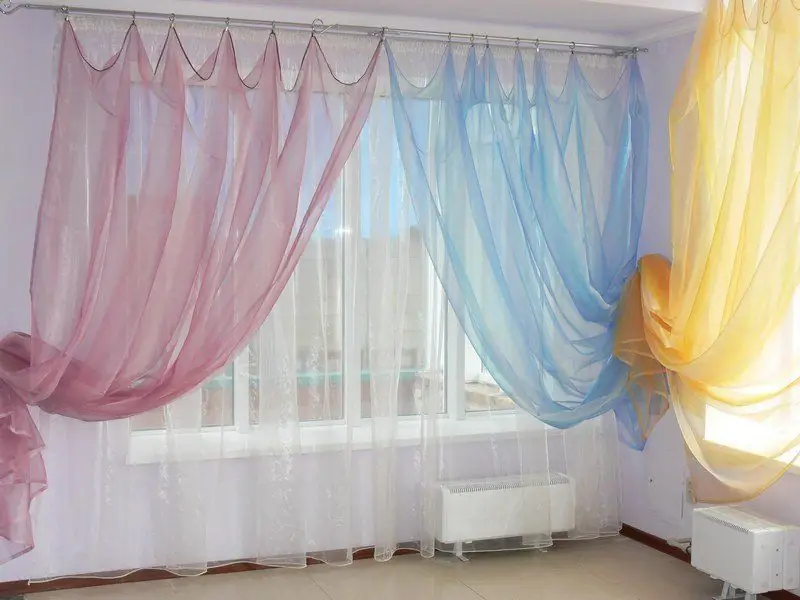
Table of contents:
- Author Bailey Albertson [email protected].
- Public 2023-12-17 12:53.
- Last modified 2025-01-23 12:41.
Tips for properly washing different types of curtains

They say that the windows are the eyes of the house. This means that curtains can be compared to makeup. If applied correctly, your eyes will look great too. Curtains, like any thing, require care, but not every fabric is so easy to wash. In this article, we will talk about how to wash curtains correctly, so as not only to get rid of dirt and dust, but also to preserve their beauty for a long time.
Content
- 1 Washing features
- 2 Types of curtains
- 3 Delicate fabrics: wash tulle, organza and yarns
- 4 Rules for the care of roller blinds, Roman and linen curtains
- 5 Other types of fabrics: wash correctly
- 6 A few secrets to help you
- 7 Video about washing curtains
Washing features
Each fabric requires a different approach, but there are some general rules that apply to washing curtains. Previously, this was done exclusively by hand, but most modern washing machines are equipped with programs that allow you to handle any fabrics with care.

Modern washing machines are good at washing curtains.
- Aim to machine wash only thick curtains. To do this, select the delicate mode.
- Use the extra rinse function. Detergents remaining on the surface of the fabric fade under the sun's rays, not only discoloring, but also destroying the material.
- Spinning should be done at minimum speed, or better - generally by hand.
- Remember to carefully read the instructions on the packaging of the laundry detergent or detergent you are using.
- Curtains made of different fabrics cannot be washed at the same time. The same goes for washing with other items.
- For a more gentle wash, load the drum only halfway.
- You need to dry the curtains in a straightened form, avoiding direct sunlight. Iron them when they are half dry, or hang them wet - the curtains will smooth out under their own weight.
Ironing curtains also requires a certain approach. Be sure to understand the modes that the iron is equipped with, this will help you navigate the temperature appropriate for the type of fabric. The soleplate of the iron must be clean. Ironing should be done from the inside out, through a white cotton cloth.
Types of curtains







Delicate fabrics: we wash tulle, organza and threads
We use curtains from these fabrics as so-called "daytime" ones. These lightweight, translucent materials give the room a complete, festive and cozy look and therefore require maintenance.
Tulle curtains are the easiest to clean. They are easy to wash, dry quickly and smooth out. It is better to wash it by hand, or using a delicate mode without spinning in the machine. It is enough to wash tulle curtains as it gets dirty, once a year, a maximum of two if you think that dust from the street regularly enters your house through the windows.
- the tulle should be soaked in warm water (30-40 degrees) for 2 hours, adding a little detergent;
- after soaking, the tulle is placed in a washing machine, setting a delicate mode without spinning and a temperature of 30 degrees;
- at the end of washing, shake the tulle without squeezing so that there are no creases left, and hang it evenly;
- so that the tulle does not wrinkle during washing, place it first in a special net or white pillowcase.
Organza curtains can be machine washed in the same way as tulle. But since organza is a very delicate fabric, you need to use special mild detergents to care for it. Better, after all, to give preference to hand wash. The curtains must be pre-soaked in cold water several times until the water remains clear.

Tulle and organza require a delicate wash
When the wash is finished, do not wring out the organza, but hang it wet on the curtain rod. Most of the types of this fabric do not need ironing, but straighten under their own weight.
Curtains made of threads (they are also called muslin or rope), especially if they include bugles, look great in any interior, but they also require special care.
- Dissolve a little powder in warm water and place the muslin curtain there for half an hour. Then add hot water (40 degrees) and remember the muslin gently with your hands.
- After you finish washing, drain the dirty water and rinse the curtain out of the shower. Let the water drain and hang the curtain over the eaves.
- If there are no decorative elements on the curtains-threads, for example, bugles, then simply twist them, put them in a pillowcase or a special bag, and send them to the washing machine on a delicate mode without spinning.
- At the end of the wash, remove the curtains and hang them on the curtain rod.
Rules for the care of roller blinds, Roman and linen curtains
During production, roller blinds and roman blinds are treated with special compounds that repel dust, protect fabrics from fading and prevent them from stretching. Therefore, with proper care, washing is usually required infrequently - once every 3-4 years.
- Use the dry wash method regularly. This will require a vacuum cleaner and a delicate attachment to it. Run the vacuum cleaner carefully over the surface of the fabric so as not to deform it with the air jet.
- Most stains on Roman and roller blinds can be removed with a simple eraser. Stubborn stains, such as grease, should be removed with a stain remover, applied to the area and allowed to stand for as long as the instructions require. Rinse gently with water, but do not rub.
- If necessary, roller blinds and roman blinds should be washed, but only on a gentle cycle and using neutral products. Dilute the product in warm water and rub the curtain with a soft sponge with light circular motions. Rinse well in running water, preferably under the shower.
- Dry such curtains by spreading them on a flat horizontal surface. This will help prevent the product from stretching.

Roller blinds and roman blinds require dry maintenance
Linen curtains are of two types, and their washing depends on it. For example, a finished canvas will require 40 degrees, and a painted one - 60 degrees. Linen is the most unpretentious material used for curtains, but it is preferable to choose a hand wash. This fabric can shrink. To prevent this from happening, dry linen curtains by spreading them out on a flat surface and iron them with moisture at a high temperature.
Other types of fabrics: wash correctly
Silk curtains require a very careful attitude. You need to wash them on a delicate mode, putting them in a pillowcase or bag for washing. The water temperature is no more than 30 degrees. Silk cloth may shed during washing. To avoid this, add some vinegar to the water.
Curtains made of acrylic and viscose are washed at a temperature of 30-40 degrees, on a gentle mode, using a product for fine fabrics.
Velvet curtains must be turned inside out before washing. Wash on a delicate mode, at 30 degrees, wring out by hand.

Curtains made of brocade, moire, or glue-based curtains are best dry-cleaned
Durable cotton curtains tolerate heat well, so they can be washed at 60 degrees in the normal wash cycle using a fine fabric detergent. Also, polyester is not capricious in care, but temperatures exceeding 40 degrees can lead to complex folds.
Woolen curtains should be hand washed at 30 degrees. Use special products or shampoo for this. Squeeze gently without twisting.
Wash chintz curtains in cool salted water, add vinegar while rinsing.
In no case should you wash your own brocade curtains, moire curtains, as well as lambrequins made on an adhesive basis - dublerin, bandeau.
A few secrets to help you
Curtains made from lightweight fabrics, such as tulle or organza, often turn yellow over time. In addition, the curtains are prone to various types of dirt. Simple folk recipes will help them return to their former whiteness and purity

Use folk remedies to clean curtains from dirt
- Soak the yellowed tulle in salt water before washing (for 1 liter of water, 1 tablespoon of salt). Add 2 tablespoons to hot water. hydrogen peroxide 3%, 1 tbsp. ammonia. Spread the tulle and place in this solution for 30 minutes. Rinse thoroughly.
- Dip the organza in water in which a small amount of starch is dissolved - 1 tbsp. for 3 liters of water. Hold for about half an hour, and the curtain will not only return whiteness, but will also keep its shape perfectly.
- Dry tea or coffee stains on the curtains with a blotting paper, apply a little foam of detergent and rinse with water. Dry excess moisture with a napkin.
- A mixture of vinegar and ammonia will help remove traces of fruit juice. Apply it, dry it, rinse it off with clean water.
- Try to remove red wine spilled on the curtain immediately from the fabric, and sprinkle the stain with table salt. When the fabric is dry, brush off the salt and rinse with water.
- White wine stains are treated with a solution of ¾ methyl alcohol and ¼ water, after which they are dried and washed with detergent.
- If chewing gum gets on the curtain or curtain, freeze it with ice cubes in a bag. After that, the gum is easily removed with a spatula.
- After complete drying, chocolate stains are treated with a detergent and washed with water, after which they are dried with napkins.
- Ethyl alcohol and turpentine will help remove a ballpoint pen or lipstick from the curtains.
- After cooling, drops of candle wax must be crushed and scraped off the fabric. iron the remaining grease stain through a blotter with a hot iron.
These tips will help you keep your curtains clean at all times and not be afraid of any contamination.
Video about washing curtains
As you can see, washing curtains is not a difficult task at all, requiring only attention and accuracy. Tell us in the comments what means and methods you use to ensure that your curtains are always neat, clean and do not lose their shape. Comfort for your home!
Recommended:
How And How To Wash Blood From Clothes And Linen At Home, Ways Of Washing By Hand Or In A Washing Machine + Photos And Videos

How to effectively remove fresh or old blood stains on clothes made from different fabrics? We apply folk advice in practice, using materials at home
How To Wash Curtains In A Washing Machine, Manually Or Clean Them Without Removing Them From The Eaves, Cleaning Features For Various Types Of Products

How to wash curtains: main stages and features. How to wash depending on material, construction and dirt. Other helpful tips
How To Wash An Apple From Clothes (for Children Or Adults), How To Wash Your Hands Of This Fruit, Ways To Remove Stains From Apple Juice And Other Tips

Methods for cleaning white and colored things from apple traces. Their pros and cons. How to remove old tracks. How to wash your hands after peeling apples
Filament Curtains For The Kitchen: Advantages And Disadvantages Of Curtains With Threads, Varieties, Unusual Solutions With A Photo

What are filament curtains, can they be used in the kitchen. How to choose the color and type of curtains. Design options, draperies. Review of popular models
How To Properly Wash Makeup Brushes, How Can You Wash Cosmetic Sponges (including For Foundation), How Often You Need To Do It

How often and correctly you should wash your makeup brushes and sponges. Home and professional cleaning tools for cosmetic tools. Instructions. Video
